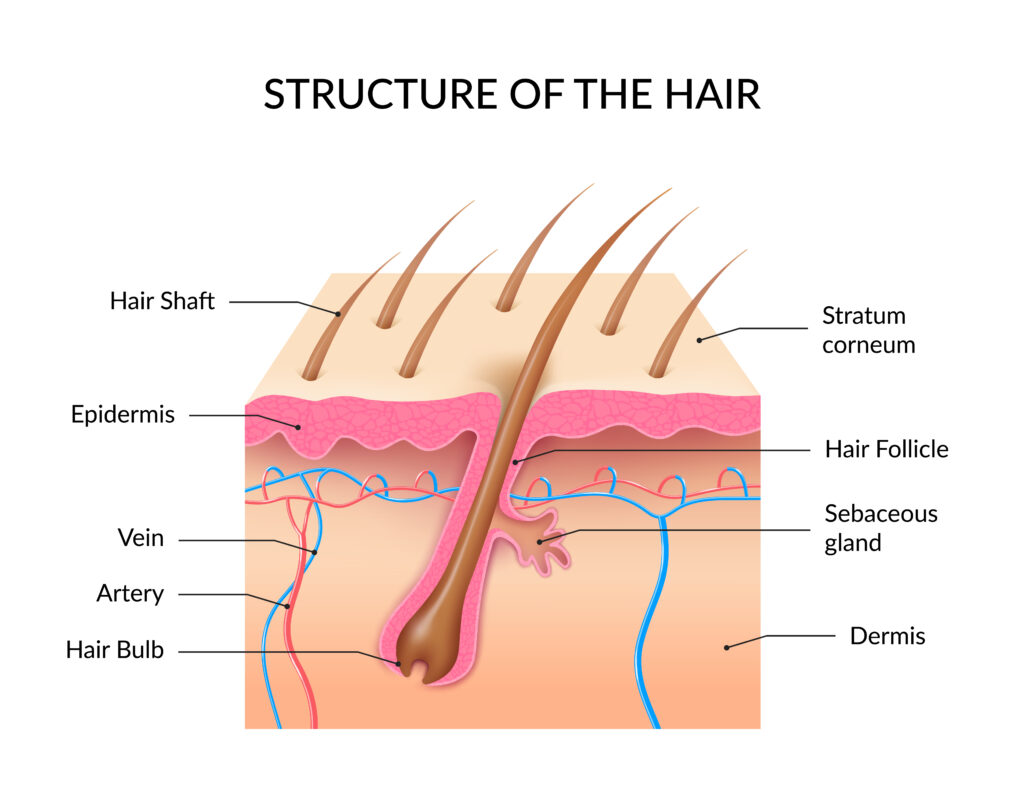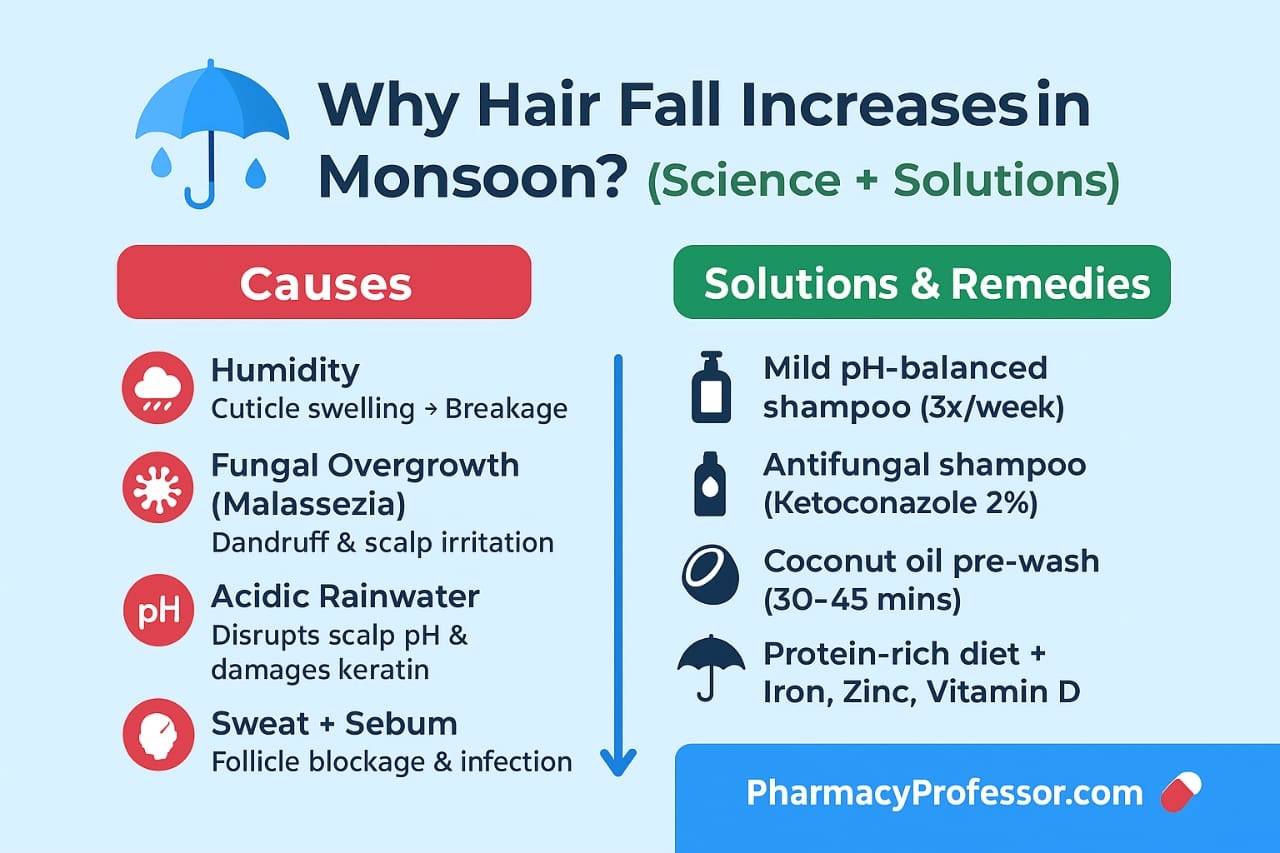Introduction
The monsoon season is refreshing and brings relief from the scorching heat, but it also comes with its own set of challenges for your hair. Many people notice hair fall in monsoon, along with frizz, dryness, or weak strands. The main reasons include high humidity, excess moisture on the scalp, fungal growth, sticky sebum buildup, and exposure to slightly acidic or polluted rainwater. All these factors make hair more prone to breakage, dullness, and even thinning.
Knowing the science behind hair fall in monsoon helps you take the right steps to protect your hair. Simple practices like proper cleansing, controlled oiling, eating a balanced diet, and taking care of your scalp can make a huge difference. For those who prefer natural remedies, the Truths of Charak Samhita and Ayurveda offer tried-and-tested Ayurvedic tips to strengthen hair, improve scalp health, and maintain overall wellness—perfectly complementing your regular hair care routine.

Human Hair
Human hair is a unique feature of mammals and plays a key role in beauty, identity, and protection. Composed mainly of keratin, it emerges from follicles in the scalp and other body areas. Beyond appearance, hair also regulates temperature and acts as a natural barrier against sunlight, dust, and minor injuries.
Types of Hair & Their Functions
Hair can be categorized as lanugo (fine fetal hair), vellus (soft body hair), and terminal (thicker scalp, beard, and pubic hair). Each type serves a purpose—lanugo for warmth in the womb, vellus for subtle protection, and terminal hair for insulation, protection, and aesthetics. The balance of these hair types changes with age and hormones.
How Hair is Formed
Hair formation begins inside the follicle, where specialized matrix cells divide rapidly. As these cells move upward, they undergo keratinization, hardening into the hair shaft. Melanocytes in the follicle inject pigment, giving hair its color. Proper nutrition, oxygen supply, and hormonal balance are vital for healthy hair formation and continuous growth.
Hair Composition & Structure
Hair is primarily made up of α-keratin proteins, with additional components like lipids, water, and trace elements. Melanin provides pigmentation, while disulfide bonds ensure strength and elasticity. This unique biochemical structure determines how hair behaves—whether straight, curly, or wavy—and influences its resilience against external stressors like heat, humidity, or chemical damage.
Internal Parts of Hair
- Hair Follicle: A tunnel-shaped structure anchoring hair in the dermis.
- Dermal Papilla: Supplies blood and nutrients, crucial for growth.
- Sebaceous Gland: Secretes sebum, keeping hair shiny and protected.
Together, these structures form a mini-organ that constantly regenerates, provided the scalp environment remains healthy and well-nourished.
Layers of Hair Shaft
The shaft has three main layers:
- Cuticle (Outer Layer): Transparent shield preventing water loss and damage.
- Cortex (Middle Layer): Rich in keratin and melanin, providing strength, elasticity, and color.
- Medulla (Inner Core): Found in coarse hair, its role is less clear but may aid thickness. These layers together define hair’s durability and texture.
Hair Growth Cycle
Anagen Phase (Growth)
This is the most active phase, lasting 2–6 years. Around 85–90% of scalp hair is in this stage at any given time. Cells rapidly divide, and hair grows about 1–1.5 cm per month. Longer anagen phases result in longer hair, influenced by genetics, hormones, and nutrition.
Catagen Phase (Transition)
A short transitional stage lasting 2–3 weeks, where the hair follicle shrinks and detaches from its blood supply. Only about 1–2% of hair is in catagen at once. Although no growth occurs, this phase is crucial to prepare the follicle for renewal.
Telogen Phase (Rest)
Lasting 2–4 months, the telogen phase allows old hair to rest before shedding. Normally, 10–15% of hair is in this phase. New anagen growth begins underneath, pushing out the resting hair. Excess hair in telogen due to stress or illness leads to diffuse shedding called telogen effluvium.
Daily Hair Loss Rate
It is natural to lose about 50–100 strands of hair each day. These shed hairs are replaced by new ones growing in the same follicle. Excessive loss beyond this range may signal nutritional deficiencies, stress, hormonal imbalance, or scalp disorders. Understanding normal shedding helps differentiate routine hair fall from potential medical problems.
When Hair Loss Becomes a Problem
Hair loss becomes a concern when it exceeds daily limits, appears as sudden shedding, patchy bald spots, or overall thinning. Conditions like alopecia areata, androgenetic alopecia, scalp infections, or lifestyle-related factors can contribute. Identifying the root cause early and seeking medical or dermatological advice is crucial to prevent long-term follicle damage.
Scientific Reasons for Hair Fall in Monsoon
1. High Humidity and Hair Shaft Damage
Human hair is made of α-keratin proteins, which give strength, elasticity, and smoothness. During monsoon, high humidity causes hair shafts to absorb moisture from the air, making the cuticle (the outer layer of hair) swell.
When the cuticles lift, hair strands rub against each other, creating friction and tangling. Over time, repeated friction weakens the hair shaft, leading to breakage, split ends, and increased hair fall in monsoon.
Additionally, wet hair is more fragile and prone to mechanical damage from brushing or tying tightly, which further worsens hair loss. People with naturally curly or wavy hair often face more breakage due to cuticle lifting in humid conditions.
Prevention Tips:
- Use a mild, pH-balanced shampoo to clean hair gently without stripping natural oils.
- Avoid brushing wet hair aggressively.
- Apply lightweight protective oils like coconut or argan oil before going out in humid conditions.
📖 Reference: Robbins CR. Chemical and Physical Behavior of Human Hair. Springer, 2012.
2. Fungal Overgrowth on Scalp
Excess moisture during monsoon creates a damp environment on the scalp, ideal for fungi like Malassezia furfur. This fungus feeds on natural scalp oils (sebum) and produces irritating fatty acids.
The result: dandruff, scalp itching, inflammation, and weakened hair follicles, which cannot support healthy hair growth. Continuous fungal activity can lead to chronic scalp issues and aggravate hair fall in monsoon.
People who frequently leave their hair wet or use occlusive oils overnight are more prone to fungal overgrowth.
Prevention Tips:
- Wash hair regularly with an antifungal shampoo (2% Ketoconazole) if dandruff is present.
- Dry hair thoroughly after exposure to rain or sweating.
- Avoid sharing combs or hair accessories to prevent fungal spread.
3. Acidic and Polluted Rainwater
Monsoon rain often carries acidic components (pH 4.2–5.6) and dissolved pollutants like SO₂ and NOx. Direct contact with hair and scalp can:
- Disrupt the natural scalp pH (~5.5)
- Make hair strands brittle
- Weaken the hair shaft’s keratin structure
- Increase hair fall in monsoon
Polluted rainwater can also leave residues on hair, attracting dirt and further clogging hair follicles. Over time, this damages both the hair shaft and the scalp, reducing hair density.
Prevention Tips:
- Cover your hair with a scarf or umbrella while outside.
- Rinse hair with pH-balanced water or mild shampoo after exposure to rain.
- Avoid chemical-laden styling products during wet conditions to prevent extra stress on hair.
4. Sweat and Sebum Accumulation
In humid conditions, sweat production increases. Sweat mixes with natural scalp oils (sebum) to form a sticky layer that:
- Blocks hair follicles
- Causes folliculitis (inflammation of hair follicles)
- Weakens the hair roots, leading to increased hair fall in monsoon
This is why people with oily scalps often notice more hair loss during the rainy season. Over time, clogged follicles can also reduce hair growth and lead to thinning.
Prevention Tips:
- Keep hair clean and dry, especially after sweating or getting wet in the rain.
- Avoid tight hairstyles that trap moisture.
- Massage scalp gently to improve circulation and maintain follicle health.
📖 Reference: Trüeb RM. Scalp health and seasonal hair loss. Clin Dermatol. 2009;27(1):12–19.
Proven Tips to Prevent Hair Fall in Monsoon
1. Use Mild, pH-Balanced Shampoo
Proper scalp cleansing is the first step to reduce hair fall in monsoon. Humidity and sweat can create a sticky layer of sebum and dirt on the scalp, promoting fungal growth and follicle blockage.
- Use a mild shampoo with pH 4.5–5.5 2–3 times a week.
- For dandruff-prone or oily scalp, 2% Ketoconazole shampoo is clinically proven to reduce fungal overgrowth and control seasonal hair fall.
- Avoid harsh shampoos with sulfates and parabens, as they can strip natural oils, making hair brittle and more prone to breakage.
Tip: Massage gently in circular motions to improve blood circulation and ensure deep cleansing.
2. Oiling the Scientific Way
Oiling is essential but must be done correctly in humid weather to prevent fungal overgrowth.
- Coconut oil contains lauric acid, which penetrates the hair shaft and helps prevent protein loss.
- Apply 30–45 minutes before shampooing, instead of overnight, during monsoon to avoid creating a damp environment for fungi.
- Light oils like argan or almond oil can also provide moisture without weighing hair down.
📖 Reference: Rele AS, Mohile RB. Effect of coconut oil on hair damage. J Cosmet Sci. 2003.
3. Maintain Proper Nutrition
Hair is primarily made of protein, and micronutrients play a vital role in follicle strength. A balanced diet can help prevent hair fall in monsoon naturally:
- Protein: 1–1.2 g/kg/day (Eggs, Paneer, Pulses, Lean Meat)
- Micronutrients: Iron, Zinc, Vitamin D, Biotin
- Hydration: Drink adequate water to maintain scalp moisture.
Additionally, include Immunity-Boosting Superfoods for COVID-19 in your diet to support overall wellness and hair health. Foods like amla, moringa, and turmeric help strengthen follicles and reduce oxidative stress.
4. Protect from Rain and Moisture
Direct exposure to rainwater or wet hair for long periods can exacerbate hair fall in monsoon:
- Always cover hair with a scarf or umbrella when outside.
- Avoid prolonged wet hair; rinse or wash hair after heavy rain.
- Dry hair naturally and avoid hot blow dryers, which can further weaken strands.
- Keep hairstyles loose to reduce tension on hair follicles.
5. Quick Home Remedies
Natural remedies can complement regular hair care routines:
- Aloe Vera Gel: Soothes scalp irritation, reduces inflammation, and maintains hydration.
- Onion Juice: Rich in sulfur, it strengthens hair follicles, boosts circulation, and promotes hair growth.
- Neem or Tea Tree Oil: Natural antifungal properties prevent dandruff and reduce hair fall in monsoon.
These remedies are safe for regular use but should be tested for allergies before application.
6. Lifestyle Adjustments
Lifestyle choices have a direct impact on hair health:
- Avoid sharing combs or hair accessories to prevent fungal infections.
- Manage stress: High cortisol levels from stress can worsen hair loss.
- Sleep well: Adequate rest supports optimal hair growth cycles.
For additional natural remedies and traditional approaches, refer to Truths of Charak Samhita and Ayurveda for time-tested Ayurvedic practices.
7. When to Consult a Dermatologist
Seek professional help if:
- Hair fall exceeds 100 strands/day consistently.
- Patchy bald spots or thinning areas appear.
- Persistent dandruff, itching, or scalp irritation remains despite home care.
Dermatologists may recommend:
- Scalp examination for fungal infections.
- Blood tests to check Iron, Vitamin D, and Thyroid levels.
- Prescription treatments like Minoxidil or medicated antifungal therapies to control hair fall in monsoon effectively.
Frequently Asked Questions (FAQ) – Hair Fall in Monsoon
Q 1. Why does hair fall increase during the monsoon season?
Ans:- Hair fall in monsoon increases due to high humidity, fungal overgrowth, sweat and sebum accumulation, and exposure to acidic or polluted rainwater. These factors weaken hair shafts and follicles, making hair prone to breakage and fall.
Q 2. How can I prevent hair fall in monsoon naturally?
Ans:- You can prevent hair fall in monsoon by:
- Using mild, pH-balanced shampoos
- Proper oiling before shampooing
- Maintaining balanced nutrition (protein, iron, zinc, biotin)
- Protecting hair from rain and moisture
- Practicing lifestyle adjustments like stress management and adequate sleep
Q 3. Are home remedies effective for controlling hair fall in monsoon?
Ans:- Yes, natural remedies such as aloe vera gel, onion juice, neem oil, and tea tree oil help reduce scalp inflammation, fight fungal infections, and strengthen hair follicles, effectively minimizing hair fall during the rainy season.
Q 4. When should I consult a dermatologist for hair fall in monsoon?
Ans:- Consult a dermatologist if:
- Hair fall exceeds 100 strands/day consistently
- Patchy bald spots appear
- Persistent dandruff, scalp irritation, or fungal infections remain despite home care
Dermatologists can recommend scalp examinations, blood tests (Iron, Vitamin D, Thyroid), or prescription treatments like Minoxidil or antifungal therapies.
Q 5. Can diet affect hair fall in monsoon?
Ans:- Yes. A balanced diet rich in protein, iron, zinc, Vitamin D, and biotin supports hair growth and follicle strength. Including immunity-boosting foods like moringa, amla, and turmeric can also reduce oxidative stress and promote healthier hair.
Q 6. Does frequent washing reduce hair fall in monsoon?
Ans:- Frequent washing with mild, pH-balanced shampoo helps remove excess sweat, sebum, and fungi, reducing hair fall in monsoon. However, over-washing with harsh shampoos can strip natural oils and weaken hair, so 2–3 times per week is ideal.
Conclusion
Hair fall in monsoon is a common seasonal concern, caused mainly by high humidity, fungal growth, acidic or polluted rainwater, and sebum buildup. By adopting these 7 proven tips—including proper scalp cleansing, scientific oiling, balanced nutrition, lifestyle adjustments, and timely dermatologist consultation—you can strengthen hair, reduce breakage, and maintain healthy hair during the rainy season.
For a holistic approach to hair and overall wellness, you can explore Truths of Charak Samhita and Ayurveda for natural remedies. Additionally, including immunity-boosting foods as discussed in Immunity-Boosting Superfoods for COVID-19 can further support hair and scalp health.
By combining scientific care routines with natural, nutrient-rich practices, you can effectively control hair fall in monsoon and enjoy strong, lustrous hair throughout the season.
Disclaimer
The content in this blog is for educational purposes only. It provides general information about hair fall in monsoon, home remedies, preventive tips, and nutrition. It is not a substitute for professional medical advice. If you experience severe hair loss, scalp infections, or persistent dandruff, please consult a qualified dermatologist or healthcare professional before trying any treatments or remedies mentioned here

